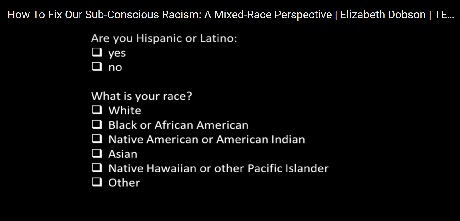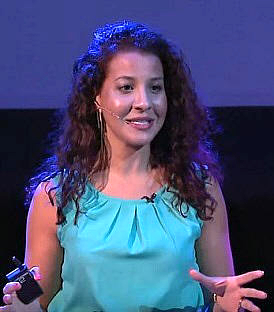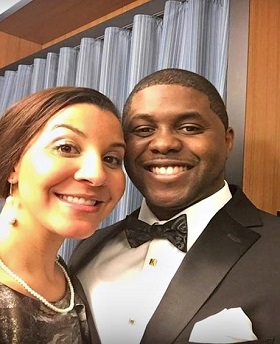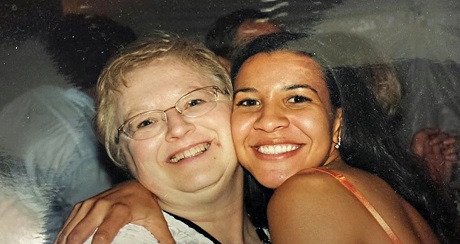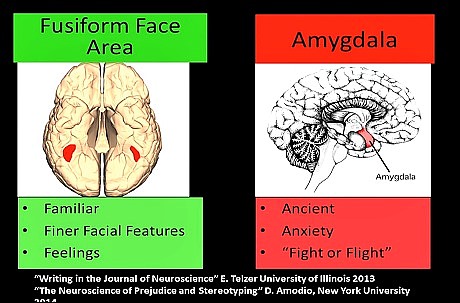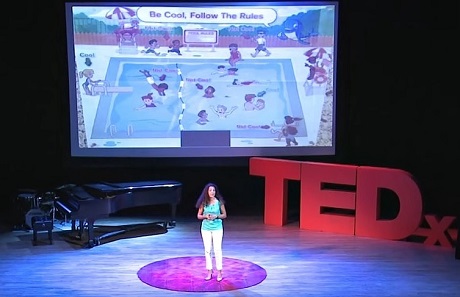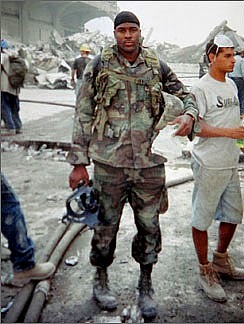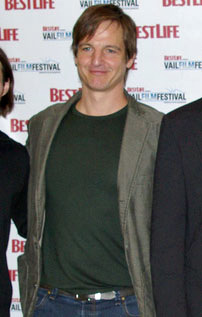
|
Elizabeth Dobson
delivered 17 September 2016, Miller Symphony Hall, Allentown, PA
[AUTHENTICITY CERTIFIED: Text version below transcribed directly from audio (2)] Good afternoon. I’m here to offer an alternative to this box. Because this box has been a source of frustration for people like me. Let me clarify:
This box, with these questions, has been. Now, for many people this question carries the same weight as, “What is your name?” But for multiracial people it can be a bit more of a challenge. See, when I was younger, growing up as a mixed race person, I often struggled with these boxes -- and where I fit in. I often felt caught between them because I wasn’t quite white enough and I wasn't quite black enough. And so, these boxes would often remind me that my race isn't so simple. Now, the good news is, even though it took me awhile to get here, I have come to realize that I am so much more than just these boxes. But aren't we all? So, I’m here to share with you how my experiences as a mixed-race woman has taught me a way to help all of us get past this box; and for some, even fix our our subconscious racism, so that we can better engage with people who are different from us.
So, to give you some context here, I am a biracial woman who was adopted as a baby into an all-white family. And I -- we happened to grow up in a rural town in Pennsylvania that was also primarily all-white. So, needless to say, I was definitely, like, the “black girl” in my grade. And when I went on to college and moved on to bigger areas like Pittsburgh, and then later New York, I learned some new things about myself, and some new terms like -- I’m not just mixed; I’m ethnically ambiguous, which simply means other people didn't know what boxes to use for me either. So, at least I wasn’t the only one who was confused, right? I mean, I’ve literally have had conversations go like this:
Many times people are so desperate to know my race, I can practically see their brains struggling trying to figure out which box to put me into. It’s almost like they’re trying to shove a round peg into a square hole, but it doesn’t completely fit. And at first I felt like this unknown, gypsy-like status further alienated me, but then I learned to have some fun with it. And so I started asking people to just guess what they thought I was. It became a game of, like , "Which box will I go in to today, Bob?"1 And I've heard absolutely everything -- from Dominican to Brazilian, Italian, Greek, Syrian, black and white mixed, Puerto-Rican and Israeli mixed. One guy on a plane actually insisted that I must be a Sephardic Jew because I looked just like his friend who is a Sephardic Jew. So, you know, that must be it. And as much as this question would bother me at times, I've come to realize that the question, “What are you?” -- or better yet, “Who are you?", needs to be asked. You see, something almost magical would happen when people would ask me. You know, I'd start to share with them about my background, my family, you know, where I grew up. And while my story is somewhat unique, the magic is we were now engaged in a conversation. So, you know, that race box that they were once so desperately trying to fit me into just sort of magically disappears. And all that’s left is the round peg: Me. So, now we're engaged in conversation based on my intelligence, my character, my personality -- which is how it should be. You see, because ethnically ambiguous people can't easily be categorized, we at least get the privilege of having a conversation to share that we are more than just our race. But everybody deserves to have that conversation, to share that you are more than just your race or your gender or your age, or, whatever. I'm going to continue to speak primarily to the issue of race, though, because I believe it's an especially important topic to address, and I know there's a lot of tension around it currently, and I want to help fix it. But we have to approach this conversation differently. We need to stop saying things like, “I don’t see color” -- because, quite frankly, that’s a bunch of crap -- like, you know, I mean unless you have a vision impairment or something. But I want you to see my color, and my curls, and then still proceed to like me anyway. You know, ladies, like, you know how we like our chocolate, right? Right?
Well my husband is the color of chocolate. And, he loves the movie Grease as much as he loves The Godfather; and he's intelligent, compassionate, creative.2
My mom is literally the color of milk, and if you can get -- once you get past the fact that she’s a blonde, white woman, you’ll find out that she’s incredibly well-read on many diverse world cultures. And when I was in college she would literally call me to discuss the current events affecting the African-American community almost weekly. But you wouldn’t know this about them unless you had a conversation with them. See, it's not that the labels or the boxes, I've learned, are in and of themselves the problem -- because they don’t define us. They’re just a part of our definition. And admittedly, I have spent much of my life blaming the boxes and these categories too, but we must stop trying to convince ourselves that categorizing is the issue; because the truth is we're going to categorize because that's how our brains process information. And we use it in our environment for everything -- you know, animal [versus] plant, hot [versus] cold, swipe left/swipe right -- we categorize. So, the boxes are not actually the problem; it’s the fact that we stop at the boxes -- that’s the problem. And this is important, because the face of our country is changing, and we have got to learn how to better engage with people who look different from us; because there are going to be more people of color in our country, in our work places, and even within our families. Based on the recent statistics, odds are increasing that you are going to have a grandchild, a niece, or a nephew who's a minority or mixed race. You see, the recent Pew Research Group studies found recently that millennials (or anyone born after 1980) have recently surpassed baby boomers as the largest living generation -- and we are also 43% Non-White. So it makes sense, then, that when they also noted, as of two years ago [2014], that almost half of all newborns are also Non-White. So, not only are we becoming more diverse, but we're becoming more mixed too, because, they've noted, as of last year, that now 1 in 7 marriages are interracial. See, even with these increases though, I still believe that there's far too many of us that, when we encounter somebody who's different from us, we are so quick to note the differences, make assumptions, check a box, and keep moving. Hispanic man (check). Arab woman (check). And if we’re not forced to engage with people who are different from us, most of us don’t bother to go out of our way. See, scientists have beg[un] to discover actually what happens in our brains when we -- when we encounter race. In fact, we can read someone’s race in milliseconds.
And through neuroimaging they've identified what happens...the reasons [that] our brains...are activated when we encounter different faces, actually. So, there's two regions of the brain that are activated: the fusiform face area and the amygdala. Now, the fusiform face area is actually responsible for helping us to read people as familiar. It also helps us to pick up their finer facial features, like maybe freckles, and it also helps us to properly discern and distinguish that individual's feelings, so that we can read the difference between “surprised versus shocked” or “angry versus scared”. The amygdala, on the other hand, is the part of our brain where you'll find learned conditioning for fear, anxiety, and the fight-or-flight response. So, studies have shown that when participants look at faces that are of the same race as their own, their -- the fusiform face area is heavily activated more so than the amygdala. And when people encounter faces of races that are different from themselves, you guessed it, the opposite is true -- where the amygdala goes off like crazy and the fusiform face area is weakly activated. This happens so prevalently that scientists call it the other-race effect.3 Now, this might have served a purpose, you know, in -- in tribal times where "another race" meant a different tribe, and, you know, you had to proceed with caution as you pioneer through new lands. But we are not in tribal times anymore, people. And we’re in the largest melting pot in the world. We should be able to overcome...these implicit racial biases. And there are some modern consequences if we are not intentional about correcting it. Take, for example, the amygdala. If it's activated, or overactive, the effects can be serious. I mean, think about it: Studies have shown that just by looking at somebody from a different race -- can cause you to feel anxious. No other indicators -- not their behavior, not their words -- just the fact that they look different can cause you to feel fear. Now, couple that with the decreased ability to properly read and discern that person's feelings. How easily we may confuse, you know, their feelings of confusion for being angry. Imagine how, in those split-second situations, we could be wrong. Imagine if there's two people of different races, and one of them is in a position of power, and the other isn't. Imagine if one of them has a weapon and the other is unarmed. Now, neuroscience can explain how subconscious our behavior can be, but I want to be clear. I am not offering an excuse for racism, because we still have a conscious choice to be racist or not. And if we're choosing to not be racist, then we must also choose to be intentional about correcting this subconscious thought process. And so, I've learned some things through my experiences as a mixed-race woman, and that science has confirmed, are some helpful solutions that can help all of us get past these biases and get past this box. First, we have to stop blaming the box, and these labels, because the reality is we are all different and it is okay to acknowledge those differences. It's not that we shouldn’t label people. It’s that we shouldn’t limit people. Secondly, we must be intentional in overcoming these -- this subconscious thought process. You know, specifically, we can become allies with people from different ethnic groups. You know, you might find somebody who looks different from you but maybe shares common interests, like you have the same favorite sports team. It's an easy way to start a conversation, as well. Or you could coach or mentor a young person from a different ethnic group, too. See, studies have shown that by becoming allies with somebody from a different ethnic group -- has actually [been] shown to decrease these racial biases. In one study, where white participants who at first tested with [these] implicit race biases against African-Americans -- when they just simply read a hypothetical story where a black person was a hero that saved their own life, they had an immediate and significant decrease in their implicit race biases. Now, if that can happen from just reading a hypothetical story, imagine what would happen with consistent, positive interactions in real life? Which is why we also need to hold the media and [news outlets] accountable. Like, look, it’s no secret that the news perpetuates negative stereotypes about minorities. And, quite frankly, all this does is continue to feed our subconscious anxiety. I think that's...a reason why a [large] majority of us are hesitant about engaging with people from different cultures. But this is a critical component because even with all of the positive interactions we have with each other, there's no way that we can keep up with the constant barrage of negativity from the media.
Not in small ways, like with this poster at a pool talking about the rules. Notice all the -- the children misbehaving happen to be brown. Not cool.
Or in big ways, like how in Oliver Stone’s movie World Trade Center, they changed the identity of this guy, African-American U.S. Marine Lieutenant Jason Thomas, who crawled into the rubble of 9/11 and saved two New York police officers.
The actor they chose to portray him? This guy [William Mapother]. Huge missed opportunity to portray a person of color positively and as a hero. So, it is -- considering how important stories are, whether we read them, watch them, or hear them, it is that much more important that we are intentional about correcting this. And on a personal note, you can just simply turn the news off to spare yourself from the exposure to the negativity. You could also, when you encounter somebody who looks different from you, be intentional about engaging in conversation with them. Ask yourself, “What do I know about this person? Not the group I think belong to, but this person in front of me specifically?” "Yes, [he's] an Asian man, but what else do I know about them?" "Yes, [she's] an Hispanic woman but what else do I know about her?" "What are her hobbies?" You know, "What does she do for a living?" Where [does she] go to school?" That's a great place to start. Don’t ask, “What are you?” Ask, “Who are you?” And finally, I want you to remember me and people like me. Remember how you have to have a conversation with us to even know what boxes we're associated with. How amazing would it be if we gave everybody the privilege of a conversation? To share that we're more than just our race. Because you'll find that your first box may not be correct, or even the whole story. Imagine if we treated everybody the way that people treat me -- where, when there's not one box that I fit into, I get my own unique category. But everybody should get their own unique category, not just us "ethnically ambiguous" ones. So now, when people ask me who I am: I’m a Woman. I'm a Christian. I’m Black. I'm White. I’m Adopted. I'm Insanely Competitive, Janet Jackson Fanatical, Masterful Lip-Syncing, Fun-Loving, Entrepreneur and Blogger. So: Who are You? Thank you. 1 Riff on and allusion to The Price is Right game show, whose longtime host was Bob Barker 3 Alternatively the "cross-race effect" or "other-race bias" Page Updated: 6/20/18 U.S. Copyright Status: Text = Used with permission. Images #1--#7 (screenshots) = Fair Use. Image of Lt. Thomas (Wikipedia) = Public domain. Image of Mr. Mapother (Wikipedia) = CC BY-SA 4.0 |
|
|
© Copyright 2001-Present. |
